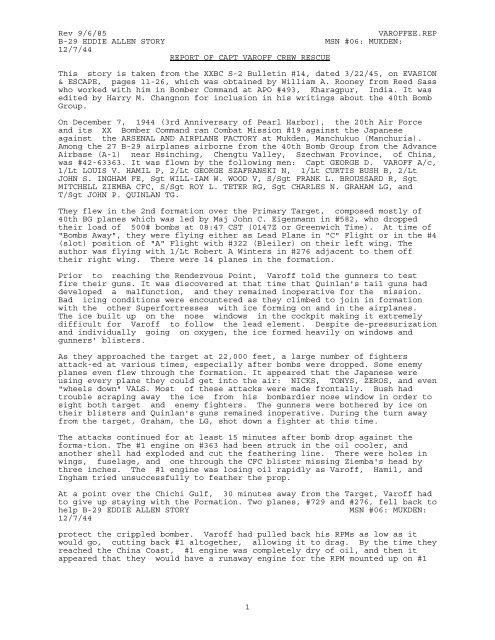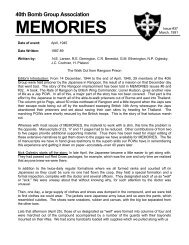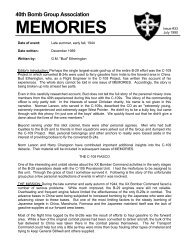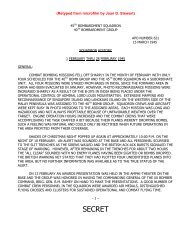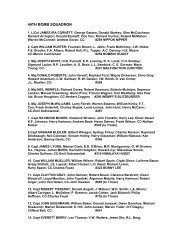Varoff Crew Rescue, December 7, 1944 - 40th Bomb Group ...
Varoff Crew Rescue, December 7, 1944 - 40th Bomb Group ...
Varoff Crew Rescue, December 7, 1944 - 40th Bomb Group ...
You also want an ePaper? Increase the reach of your titles
YUMPU automatically turns print PDFs into web optimized ePapers that Google loves.
Rev 9/6/85 VAROFFEE.REP<br />
B-29 EDDIE ALLEN STORY MSN #06: MUKDEN:<br />
12/7/44<br />
REPORT OF CAPT VAROFF CREW RESCUE<br />
This story is taken from the XXBC S-2 Bulletin #14, dated 3/22/45, on EVASION<br />
& ESCAPE, pages 11-26, which was obtained by William A. Rooney from Reed Sass<br />
who worked with him in <strong>Bomb</strong>er Command at APO #493, Kharagpur, India. It was<br />
edited by Harry M. Changnon for inclusion in his writings about the <strong>40th</strong> <strong>Bomb</strong><br />
<strong>Group</strong>.<br />
On <strong>December</strong> 7, <strong>1944</strong> (3rd Anniversary of Pearl Harbor), the 20th Air Force<br />
and its XX <strong>Bomb</strong>er Command ran Combat Mission #19 against the Japanese<br />
against the ARSENAL AND AIRPLANE FACTORY at Mukden, Manchukuo (Manchuria).<br />
Among the 27 B-29 airplanes airborne from the <strong>40th</strong> <strong>Bomb</strong> <strong>Group</strong> from the Advance<br />
Airbase (A-1) near Hsinching, Chengtu Valley, Szechwan Province, of China,<br />
was #42-63363. It was flown by the following men: Capt GEORGE D. VAROFF A/c,<br />
1/Lt LOUIS V. HAMIL P, 2/Lt GEORGE SZAFRANSKI N, 1/Lt CURTIS BUSH B, 2/Lt<br />
JOHN S. INGHAM FE, Sgt WILL-IAM W. WOOD V, S/Sgt FRANK L. BROUSSARD R, Sgt<br />
MITCHELL ZIEMBA CFC, S/Sgt ROY L. TETER RG, Sgt CHARLES N. GRAHAM LG, and<br />
T/Sgt JOHN P. QUINLAN TG.<br />
They flew in the 2nd formation over the Primary Target, composed mostly of<br />
<strong>40th</strong> BG planes which was led by Maj John C. Eigenmann in #582, who dropped<br />
their load of 500# bombs at 08:47 CST (0147Z or Greenwich Time). At time of<br />
"<strong>Bomb</strong>s Away", they were flying either as Lead Plane in "C" Flight or in the #4<br />
(slot) position of "A" Flight with #322 (Bleiler) on their left wing. The<br />
author was flying with 1/Lt Robert A Winters in #276 adjacent to them off<br />
their right wing. There were 14 planes in the formation.<br />
Prior to reaching the Rendezvous Point, <strong>Varoff</strong> told the gunners to test<br />
fire their guns. It was discovered at that time that Quinlan's tail guns had<br />
developed a malfunction, and they remained inoperative for the mission.<br />
Bad icing conditions were encountered as they climbed to join in formation<br />
with the other Superfortresses with ice forming on and in the airplanes.<br />
The ice built up on the nose windows in the cockpit making it extremely<br />
difficult for <strong>Varoff</strong> to follow the lead element. Despite de-pressurization<br />
and individually going on oxygen, the ice formed heavily on windows and<br />
gunners' blisters.<br />
As they approached the target at 22,000 feet, a large number of fighters<br />
attack-ed at various times, especially after bombs were dropped. Some enemy<br />
planes even flew through the formation. It appeared that the Japanese were<br />
using every plane they could get into the air: NICKS, TONYS, ZEROS, and even<br />
"wheels down" VALS. Most of these attacks were made frontally. Bush had<br />
trouble scraping away the ice from his bombardier nose window in order to<br />
sight both target and enemy fighters. The gunners were bothered by ice on<br />
their blisters and Quinlan's guns remained inoperative. During the turn away<br />
from the target, Graham, the LG, shot down a fighter at this time.<br />
The attacks continued for at least 15 minutes after bomb drop against the<br />
forma-tion. The #1 engine on #363 had been struck in the oil cooler, and<br />
another shell had exploded and cut the feathering line. There were holes in<br />
wings, fuselage, and one through the CFC blister missing Ziemba's head by<br />
three inches. The #1 engine was losing oil rapidly as <strong>Varoff</strong>, Hamil, and<br />
Ingham tried unsuccessfully to feather the prop.<br />
At a point over the Chichi Gulf, 30 minutes away from the Target, <strong>Varoff</strong> had<br />
to give up staying with the Formation. Two planes, #729 and #276, fell back to<br />
help B-29 EDDIE ALLEN STORY MSN #06: MUKDEN:<br />
12/7/44<br />
protect the crippled bomber. <strong>Varoff</strong> had pulled back his RPMs as low as it<br />
would go, cutting back #1 altogether, allowing it to drag. By the time they<br />
reached the China Coast, #1 engine was completely dry of oil, and then it<br />
appeared that they would have a runaway engine for the RPM mounted up on #1<br />
1
to 2800 where it remained for at least three minutes before dropping down to<br />
2400. They reached the China Coast at an altitude of 16,000'and found they<br />
had consumed all of the oxygen having been on it for about two hours both<br />
before and after the PT.<br />
<strong>Varoff</strong> continued to maintain as slow a speed as possible in order to keep the<br />
#1 prop from running away. They were bucking a terrific headwind and had a<br />
ground speed of only 120 knots despite indicating 165-170 mph. They were on<br />
a heading for SIAN in Shensi Province with both #729 and #276 escorting them<br />
when another fighter attacked them. The TONY made a pass at them from 10<br />
o'clock high until he was within 100 yards before making a climbing turn away.<br />
No damage was done to any planes as the B-29s had turned into him so that<br />
all planes could fire at the Nip.<br />
Just after they had crossed the Ping-Han Railway Line, which was<br />
recognizable beneath them, <strong>Varoff</strong> noticed a reddish glow from burning metal<br />
in the damaged engine. He immediately asked Ingham to come to <strong>Varoff</strong>'s window<br />
to inspect it. In less than the half minute it took Ingham to look out, the<br />
reddish glow became white hot. <strong>Varoff</strong> then told Hamil to alert the rest of<br />
the crew for bailout. The nose wheel was lowered and bomb-bay doors opened.<br />
<strong>Varoff</strong> then called Wemple in #729 to advise him that the #1 prop might come<br />
off at any minute and the escorts spread out to avoid being hit by the the<br />
whole prop or any of its four blades.<br />
The navigators in #729 and #276 (Capt Robert Swanson and 1/Lt Arthur Macer)<br />
had been monitoring flight locations and reported that after flying over four<br />
hours on the return flight they were at 36`15'N and 113`30'E. In #363,<br />
Szafranski had told his crewmates that since they had just crossed the Ping-<br />
Han Railway they should be jumping into friendly territory despite being<br />
behind enemy lines. The time of bailout was approximately 13:30 CST. They<br />
would be landing about 15 miles SE of the city of LI-CHENG in East-Central<br />
Shansi Province.<br />
The crew members bailed out in the following order: Quinlan TG from his<br />
tail section, Teter RG out the rear bomb-bay, followed in close order by<br />
Graham LG, and Ziemba CFC. Wood destroyed his radar equipment before he also<br />
jumped from the rear compartment. In the forward area, Szafranski N, was<br />
first out, and then Bush B, Broussard R, Hamil CP, Ingham FE, and lastly by<br />
<strong>Varoff</strong>, the pilot. The terrain beneath them was rugged mountainous country<br />
and they had expected to be able to land close together, but soon large<br />
mountains and valley separated them. The parachutists took some comfort in<br />
noting that the excort ships had circled until they reached ground.<br />
The following narrative accounts by crew members is condensed from<br />
interviews made later on their return to India.<br />
Curtis Bush was equipped with his jungle-kit, parka, winter flying pants,<br />
GI shoes and winter flying boots, and gloves. Unexpectadly, he struck the<br />
ground on the steep side of a mountain and rolled 50 feet down the slope<br />
before stopping. Upon impact with the ground, his jungle-kit ripped open,<br />
strewing contents into the snow. Bush was not wearing the C-1 Escape Vest<br />
because he could not get it and the parka to fit under his chute and he<br />
chose the parka. Within a couple B-29 EDDIE ALLEN STORY<br />
MSN #06: MUKDEN: 12/7/44<br />
minutes seven men approached him slowly, stopping several times to hold up<br />
their arms above their heads. Bush did the same thing for them. The natives<br />
gathered up his chute and equipment and clustered around him, feeling his<br />
clothes, and staring at him. They discovered his pistol and took it from him<br />
before proceed-ing to their dwelling, approximately 300 yards away on the<br />
other hillside. There they built a fire to warm him, but the smoke became so<br />
thick he had to leave. He did not have his "Pointie-Talkie" as that was left<br />
in the C-1 Vest so he had no means to communicate with the Chinese who had<br />
been trying to talk to him.<br />
The mountains were so rugged and endless that he realized it would be stupid<br />
2
to set out alone to locate the others. However, in a short time a Chinese<br />
appeared at the top of the mountain and yelled to the others apparently about<br />
other crew members. Within two hours they brought in Lew Hamil and Roy Teter.<br />
Hamil had a Pointie-Talkie book (PTb) which was very useful, but extemely slow<br />
in exchanging thoughts. The three fliers spent the night in the hut and next<br />
morning set out for an 8th Route Army Headquarters.<br />
Hamil was not warmly dressed, but had worn both C-1 Vest and the Jungle-Kit.<br />
His gun tore loose from the holster when the chute opened and badly dazed him<br />
when it struck him in the mouth. He landed on the summit of a hill, beside<br />
a deep gorge, and saved himself from sliding off by grasping brush. Hamil<br />
was chilled by the below freezing temperature and in snow, but was able to<br />
locate a shallow cave in which he could build a fire. Later he went down the<br />
hill with his chute and met up with three Chinese peasants who finally timidly<br />
approached. Hamil had remembered from the Briefing the words "May Gwaw Fay-<br />
Gee" (American Airman) and "Bah Lee Jun" (8th Route Army) which satisfied the<br />
natives who then took him to a village. At about 16:00, Hamil met up with<br />
Bush and at dusk, Teter was brought in and they were all fed.<br />
Teter had landed on a small terrace on the mountain near a farmer who<br />
understood that he wanted to find his friends. The three airmen spent the<br />
night in a dwelling and the next morning, <strong>December</strong> 8th, a Chinese appeared<br />
who could read the PTb. By 10:00, they met a soldier from the 8th Route Army<br />
who had two cotton padded Chinese coats which he gave to Hamil and Teter, as<br />
Bush was warm in his parka. This man said they would have to move on as the<br />
Japanese were out looking for the fliers. At noon they met a Mr. Wei, who<br />
served as Interpreter, and met up with Quinlan. The party walked until 02:00<br />
on the 10th when they arrived at a village where they joined up with <strong>Varoff</strong>,<br />
Szafranski, and Wood.<br />
When Quinlan had jumped, his chute would not open and he fell perhaps<br />
10,000' before he was able to reach around and rip it open by hand. He was<br />
immediately met by a farmer who took him to a village where he was fed and<br />
given a place to sleep. He met a representative of the 8th Route Army who<br />
guided him to others.<br />
William Wood was the last one out of the rear due to his delay in destruction<br />
of his radar equipment. As he drifted down, he wanted to land near two<br />
villages, but the wind blew him away and into a small valley where he struck<br />
a mountain side and was knocked unconscious. When he awakened, he found that<br />
some villagers had picked him up and carried him to a dwelling. Shortly<br />
afterwards, a soldier from 8th Route Army (8RA) arrived and took Wood to a<br />
sub-district Army Post. He met several soldiers there who could read his<br />
PTb. Wood asked the soldiers to look for the other ten fliers. The next<br />
morning Szafranski and then <strong>Varoff</strong> were brought in to the Post. On the 9th,<br />
they met two Chinese who could speak English B-29 EDDIE ALLEN STORY<br />
MSN #06: MUKDEN: 12/7/44<br />
fairly well. They started out for Colonel Ma's Headquarters where they<br />
arrived on the evening of the 10th. The next day the remaining four members,<br />
Broussard, Ingham, Ziemba, and Graham arrived there.<br />
Szafranski had delayed pulling his rip cord and tumbled from the prop wash,<br />
but when his chute opened he counted eight other parachutes before the wind<br />
twisted him around. He was blown high onto a mountain on the edge of a crevice<br />
where he<br />
landed without injury. He pulled out his Blood Chit and PTb and showed them<br />
to half a dozen natives who approached him. They took his gun, chute, and<br />
equipment with them to a dwelling on the hillside where they built a fire.<br />
One of the men informed him by the PTb that both Japanese and Guerrilla<br />
Forces were near by, and that the next morning they would take him to the<br />
Guerrillas.<br />
Captain George <strong>Varoff</strong>, the former World Pole Vault record holder at<br />
Princeton, was the last to bail out of the plane and could see eight other<br />
chutes below him as he floated down. He watched the unoccupied B-29 make two<br />
3
large circles before crashing into a peak on the third time around, bursting<br />
into smoke and flame. As he approached the ground he tried to manipulate the<br />
shroud lines as the strong wind swept him into a rugged mountainside. He was<br />
not able to gain control and he hit suddenly where his head hit a rock,<br />
knocking him unconscious. When he did regain consciousness, he found that<br />
the snow about him was red with his blood. Fortunately his chute had tangled<br />
in the brush above him, for less than a foot away was a 50-foot sheer drop.<br />
He carefully pulled himself back onto the side of the mountain by the shroud<br />
lines.<br />
He had noticed a deserted hut about a 100 yards away where he went and built<br />
a fire for his hands and feet which were almost frozen. Since his socks were<br />
wet, he was glad to find a dry pair in the Jungle-Kit and a pair of gloves.<br />
Later he went down the hill to a farm dwelling where he could see smoke. He<br />
was invited inside after saying "May Gwaw Fay-Gee" (American Airman) which<br />
was understood. Ten guerrillas showed up later who could read his PTb, fed<br />
him, and gave him a place to sleep. The next day he was taken to a village<br />
where he was given hot water, fruit, peanuts, and a mirror so that he could<br />
dress his head wound. Later he was taken to the Sub-District Army Post and met<br />
the others.<br />
Frank Broussard, the radio operator, picked up a carbine just before he<br />
bailed out. He landed on the side of a mountain, some 50 yards from a farm<br />
house. When an old man appeared, he gave him the carbine as a friendship<br />
gesture as he also made the sign of the 8th Route Army which he had<br />
remembered from the Briefing. The native seemed to understand and led<br />
Broussard toward the valley below where he met Graham, the left gunner.<br />
While they were resting, a runner arrived and informed them that another<br />
American had been found on top a nearby mountain who turned out to be Ingham,<br />
the Flight Engineer. They remained overnight in a hut before starting out<br />
early the next morning, crossing several more mountains, for a village where<br />
they met Ziemba, the CFC gunner.<br />
On the 9th of <strong>December</strong>, they set out with Chinese soldiers for the nearest<br />
Army headquarters as the Japs were reportedly searching nearby for them.<br />
Broussard and Graham went ahead as both Ingham and Ziemba were being carried<br />
on stretchers as they had injured legs in landing. They caught up with the<br />
rest of the <strong>Crew</strong> on the 13th of <strong>December</strong>. As they all said, they were<br />
wonderfully well treated by all people they met. The evaders were given food,<br />
even though it was not plent-iful, and even some luxuries such as cigarettes.<br />
B-29 EDDIE ALLEN STORY MSN #06: MUKDEN:<br />
12/7/44<br />
Charles Graham, the second man out of the rear bomb bay, landed easily,<br />
looked for habitation, but there was none in the vicinity. He walked an hour<br />
before he met two small boys who called him "May Gwaw" which he remembered<br />
meant American. They returned to his landing spot and gathered up his<br />
parachute and he was then taken to a cottage where he found Broussard. The<br />
village leader informed Graham and Broussard that another foreigner was on a<br />
nearby mountain which turned out to be John Ingham, the Flight Engineer.<br />
Ingham landed hard, injuring his feet, about 25 yards from a native dwelling.<br />
He hopped around and called out "Ding Hao" which meant nothing to the natives<br />
who came with spears and clubs. They took his gun, E&E equipment, and bound<br />
him with a loose rope. He was otherwise well treated, especially when they<br />
could see he could not walk. They built a fire for him and fed him while<br />
trying to converse in sign language, to no avail. When Graham and<br />
Broussard arrived, Ingham was given back his possessions as the Chinese had<br />
decided they were friends. The men spent the night in the dwelling, wrapped in<br />
their parachutes. Ingham stated that from the time he landed until they<br />
reached Col Ma's Headquarters, he was unable to take a step unassisted - yet<br />
he reached safety without discomfort while they were evading Jap patrols.<br />
Mitchell Ziemba, CFC gunner, landed on the side of a mountain in rugged<br />
terrain, badly spraining an ankle which made walking difficult. Some two<br />
hours after he had landed four Chinese appeared who were friendly, and as<br />
he was in no condition to move about, they carried him and his equipment<br />
4
to a dwelling where he spent the first night. He had used the Pointie-Talkie<br />
to tell the natives he wanted to be taken to the Guerrillas which they did.<br />
The entire crew of eleven fliers were reunited at Colonel Ma's Headquarters<br />
on <strong>December</strong> 13th from where they went the next day to the headquarters of<br />
Chang Ker Wei, the Minister of Production. They stayed there for ten days<br />
when they were moved to Headquarters of General Li of the 8th Route Army where<br />
they stayed over Christmas and New Years. During this time they learned of a<br />
secret airfield that had been constructed of packed material that was now<br />
frozen to a hard surface. They were informed by telegram that a plane would<br />
arrive on January 25th to make a food and clothing drop, but which was<br />
delayed by adverse weather until the 28th. They were resigned to having to<br />
walk out of occupied China until they had a call to meet the plane on February<br />
6th. This B-25 took them to Sian and again flew them the next day back to A-<br />
1. Finally on February 9th, they arrived back in India at their home base at<br />
Chakulia.<br />
The <strong>Varoff</strong> <strong>Crew</strong> were upset about missing their rendezvous on January 28th<br />
with Capt Kunz in the B-25, but welcomed the parachute drop kits and free<br />
fall drops of rations. They received bed rolls, winter mechanics' jackets,<br />
medicine, and food. Of great help to the evaders was the fact that they were<br />
briefed a week before their ordeal by L/Col William Savoie, from the 468th<br />
<strong>Group</strong>, who had survived with four of his crew on a similar walkout following<br />
the Yawata Mission of August 20th. Savoie and his men had spent three months<br />
in the hands of the Communist New 4th Army and had information about the 8th<br />
Route Army soldiers. It was important to make early contacts and have<br />
confidence in the Guerrillas.<br />
Captain George <strong>Varoff</strong> and his fellow crew members were flown back to the USA<br />
in War Weary B-29s. They left Chakulia, India on Washington's Birthday,<br />
February 22 1945. It was a policy of the Military that men who had escaped<br />
from the Japanese B-29 EDDIE ALLEN STORY MSN<br />
#06: MUKDEN: 12/7/44<br />
or areas they occupied would be returned home. They had done their duty!<br />
This space and additional pages will be filled by comments from<br />
surviving crew members from letters and interviews with Changnon,<br />
especially on what they can recall about the two months spent<br />
with the Communist Chinese before they were flown back to A-1.<br />
B-29 EDDIE ALLEN STORY MSN #06: MUKDEN:<br />
12/7/44<br />
B-29 EDDIE ALLEN STORY MSN #06: MUKDEN:<br />
12/7/44<br />
B-29 EDDIE ALLEN STORY MSN #06: MUKDEN:<br />
12/7/44<br />
B-29 EDDIE ALLEN STORY MSN #06: MUKDEN:<br />
12/7/44<br />
B-29 EDDIE ALLEN STORY MSN #06: MUKDEN:<br />
12/7/44<br />
5


